8.1: More Parabolas
( \newcommand{\kernel}{\mathrm{null}\,}\)
By the end of this section, you will be able to:
- Graph vertical parabolas
- Graph horizontal parabolas
- Solve applications with parabolas
Before you get started, take this readiness quiz.
- Graph: y=−3x2+12x−12.
- Solve by completing the square: x2−6x+6=0.
- Write in standard form: y=3x2−6x+5.
In this chapter we will be looking at the conic sections, usually called the conics, and their properties. The conics are curves that result from a plane intersecting a double cone—two cones placed point-to-point. Each half of a double cone is called a nappe.
There are four conics—the circle, parabola, ellipse, and hyperbola. The next figure shows how the plane intersecting the double cone results in each curve.
Each of the curves has many applications that affect your daily life, from your cell phone to acoustics and navigation systems. In this section we will look at the properties of a parabola
Graph Vertical Parabolas
The next conic section we will look at is a parabola.
Previously, we learned to graph vertical parabolas from the general form or the standard form using properties. Those methods will also work here. We will summarize the properties here.
Vertical Parabolas
|
General form y=ax2+bx+c |
Standard Form y=a(x−h)2+k |
|
|---|---|---|
| Orientation | a>0 up; a<0 down | a>0 up; a<0 down |
| Axis of Symmetry | x=−b2a | x=h |
| Vertex | Substitute x=−b2a and solve for y. |
(h,k) |
| y-intercept | Let x=0 | Let x=0 |
| x-intercepts | Let y=0 | Let y=0 |
The graphs show what the parabolas look like when they open up or down. Their position in relation to the x- or y-axis is merely an example.
To graph a parabola from these forms, we used the following steps.
How to Graph Vertical Parabolas y=ax2+bx+c or y=a(x−h)2+k using Properties.
Step 1: Determine whether the parabola opens upward or downward.
Step 2. Find the axis of symmetry.
Step 3. Find the vertex.
Step 4. Find the y-intercept. Find the point symmetric to the y-intercept across the axis of symmetry.
Step 5. Find the x-intercepts.
Step 6. Graph the parabola.
The next example reviews the method of graphing a parabola from the general form of its equation.
Graph y=−x2+6x−8 by using properties.
Solution:
| y=−x2+6x−8y=ax2+bx+c | |
| Since a is −1, the parabola opens downward. | |
 |
|
| To find the axis of symmetry, find x=−b2a. | x=−b2a |
|
x=−62(−1) x=3 |
|
| Identify the axis of symmetry | The axis of symmetry is x=3. |
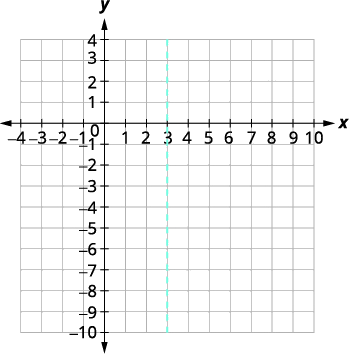 |
|
| Find the vertex. Note the vertex is on the line x=3. | |
| Let x=3 and find y so that (3,y) is on the graph, i.e., is a solution to the equation. |
y=−x2+6x−8 y=−(3)2+6(3)−8 y=−9+18−8 y=1 |
| The vertex is (3,1). | |
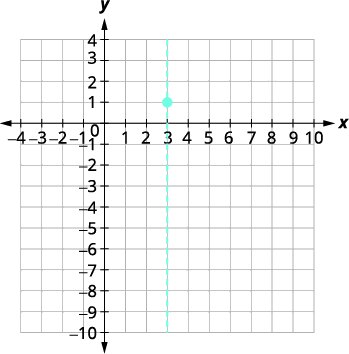 |
|
| The y-intercept occurs when x=0. Substitute x=0. |
y=−x2+6x−8 y=−(0)2+6(0)−8 y=−8 |
| The y-intercept is (0,−8). | |
The point (0,−8) is three units to the left of the line of symmetry. The point three units to the right of the line of symmetry is (6,−8). |
Point symmetric to the y-intercept is (6,−8). |
 |
|
| The x-intercept occurs when y=0. Let y=0. |
0=−x2+6x−8 |
| Factor the GCF. |
0=−(x2−6x+8) |
| Factor the trinomial. |
0=−(x−4)(x−2) |
| Solve for x. |
x−4=0 or x−2=0 x=4 or x=2 |
| The x-intercepts are (4,0),(2,0). | |
| Graph the parabola. | 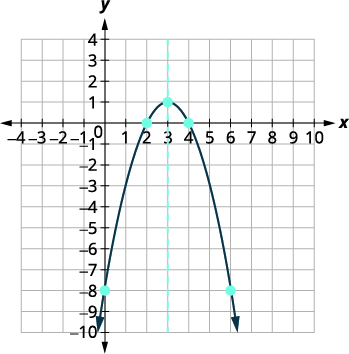 |
Graph y=−x2+5x−6 by using properties.
- Answer
-
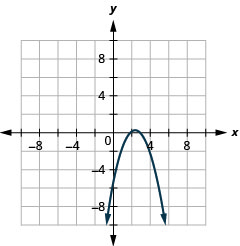
Graph y=−x2+8x−12 by using properties.
- Answer
-
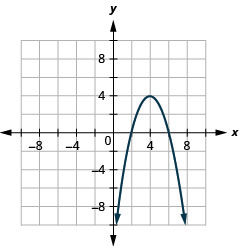
The next example reviews the method of graphing a parabola from the standard form of its equation, y=a(x−h)2+k.
Write y=3x2−6x+5 in standard form and then use properties of standard form to graph the equation.
Solution:
| Rewrite the equation in y=a(x−h)2+k form by completing the square. | |
| y=3(x−1)2+2 | |
| Identify the constants a,h,k. | a=3,h=1,k=2 |
| Since a=2, the parabola opens upward. | |
 |
|
| The axis of symmetry is x=h. | The axis of symmetry is x=1. |
| The vertex is (h,k). | The vertex is (1,2). |
| Find the y-intercept by substituting x=0, | y=3(x−1)2+2 y=3⋅02−6⋅0+5 |
| y=5 | |
| y-intercept (0,5) | |
| Find the point symmetric to (0,5) across the axis of symmetry. | (2,5) |
| Find the x-intercepts. | |
| The square root of a negative number tells us the solutions are complex numbers. So there are no x-intercepts. | |
| Graph the parabola. | 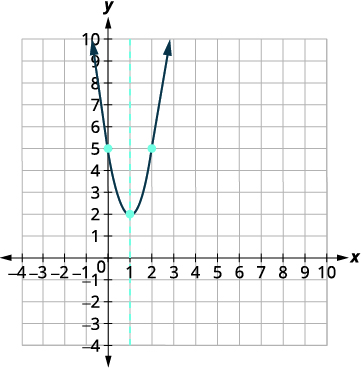 |
- Write y=2x2+4x+5 in standard form and
- use properties of standard form to graph the equation.
- Answer
-
- y=2(x+1)2+3
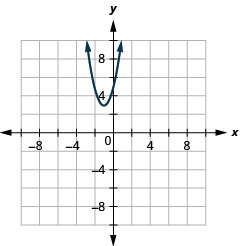
- Write y=−2x2+8x−7 in standard form and
- use properties of standard form to graph the equation.
- Answer
-
- y=−2(x−2)2+1
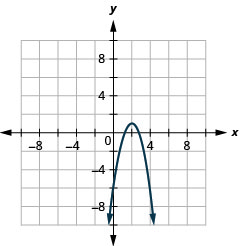
Graph Horizontal Parabolas
Our work so far has only dealt with parabolas that open up or down. We are now going to look at horizontal parabolas. These parabolas open either to the left or to the right. If we interchange the x and y in our previous equations for parabolas, we get the equations for the parabolas that open to the left or to the right.
Horizontal Parabolas
|
General form x=ay2+by+c |
Standard form x=a(y−k)2+h |
|
|---|---|---|
| Orientation | a>0 right; a<0 left | a>0 right; a<0 left |
| Axis of Symmetry | y=−b2a | y=k |
| Vertex | Substitute y=−b2a and solve for x. |
(h,k) |
| x-intercepts | Let x=0 | Let x=0 |
| y-intercept | Let y=0 | Let y=0 |
The graphs show what the parabolas look like when they to the left or to the right. Their position in relation to the x- or y-axis is merely an example.
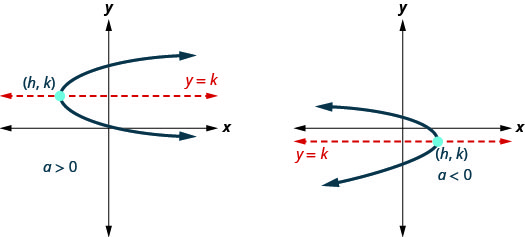
To graph a parabola that opens to the left or to the right is basically the same as what we did for parabolas that open up or down, with the reversal of the x and y variables. The graph is then the one we would get by graphing the equation with the x and y exchanged, and exchanging the x and y coordinates (e.g., if (2,3) is on the graph of the equation with the exchange, then (3,2) is on the graph of the given equation).
- Step 1: Determine whether the parabola opens to the left or to the right.
- Step 2: Find the axis of symmetry.
- Step 3: Find the vertex.
- Step 4: Find the x-intercept. Find the point symmetric to the x-intercept across the axis of symmetry.
- Step 5: Find the y-intercepts.
- Step 6: Graph the parabola.
Graph x=2y2 by using properties.
Solution:
|
x=2y2x=ay2+by+c |
|
| Since a=2, the parabola opens to the right. | |
 |
|
| To find the axis of symmetry, find y=−b2a |
y=−b2a y=−02(2) y=0 The axis of symmetry is y=0. |
| The vertex is on the line y=0. Let y=0. |
x=2y2 x=2⋅(0)2 x=0 The vertex is (0,0). |
Since the vertex is (0,0), both the x- and y-intercepts are the point (0,0). To graph the parabola we need more points. In this case it is easiest to choose values of y.
| y | x | (x,y) |
|---|---|---|
| 1 | x=2⋅12=2 | (1,2) |
| 2 | x=2⋅(2)2=2⋅4=8 | (8,2) |
We also plot the points symmetric to (2,1) and (8,2) across the y-axis, the points (2,−1),(8,−2).
Graph the parabola.

Graph x=y2 by using properties.
- Answer
-
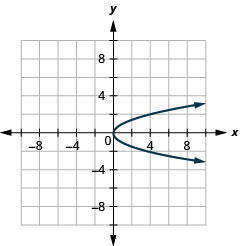
Figure 11.2.40
Graph x=−y2 by using properties.
- Answer
-
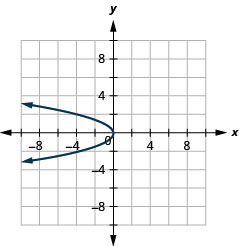
Figure 11.2.41
In the next example, the vertex is not the origin.
Graph x=−y2+2y+8 by using properties.
Solution:
| x=−y2+2y+8x=ay2+by+c | ||
| Since a=−1, the parabola opens to the left. | ||
 |
||
| To find the axis of symmetry, find y=−b2a |
y=−b2a y=−22(−1) y=1 The axis of symmetry is y=1. |
|
The vertex is on the line y=1.
|
x=−y2+2y+8 x=−(1)2+2(1)+8 x=9 The vertex is (9,1). |
|
| The x-intercept occurs when y=0. |
x=−y2+2y+8 x=−(0)2+2(0)+8 x=8 The x-intercept is (8,0). |
|
| The point (8,0) is one unit below the line of symmetry. The symmetric point one unit above the line of symmetry is (8,2) |
Symmetric point is (8,2). | |
The y-intercept occurs when x=0.
|
x=−y2+2y+8 0=−y2+2y+8 |
|
| Solve. |
y2−2y−8=0 (y−4)(y+2)=0 y−4=0 or y+2=0 y=4 or y=−2 The y -intercepts are (0,4) and (0,−2). |
|
| Connect the points to graph the parabola. | 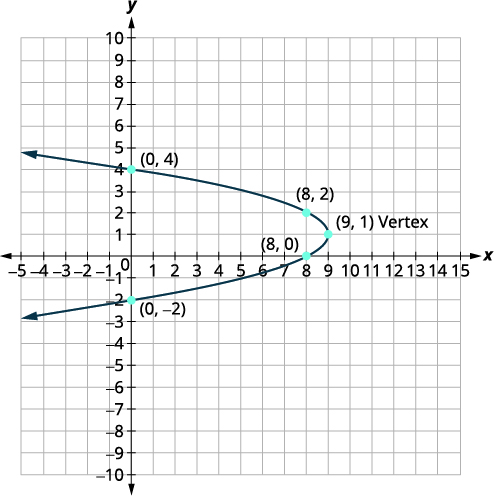 |
Graph x=−y2−4y+12 by using properties.
- Answer
-
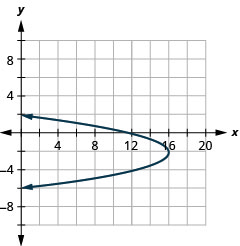
Figure 11.2.58
Graph x=−y2+2y−3 by using properties.
- Answer
-
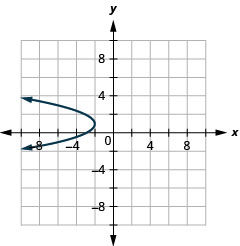
Figure 11.2.59
We will use the properties of the parabola in the next example.
Graph x=2(y−2)2+1 using properties.
Solution:
|
x=2(y−2)2+1x=a(y−k)2+h |
|
| Identify the constants a,h,k. | a=2,h=1,k=2 |
| Since a=2, the parabola opens to the right. | |
 |
|
| The axis of symmetry is y=k. | The axis of symmetry is y=2. |
| The vertex is (h,k). | The vertex is (1,2). |
| Find the x-intercept by substituting y=0. | x=2(y−2)2+1 x=2(0−2)2+1 x=9 |
| The x-intercept is (9,0). | |
| Find the point symmetric to (9,0) across the axis of symmetry. | (9,4) |
| Find the y-intercepts. Let x=0. | |
| A square cannot be negative, so there is no real solution. So there are no y-intercepts. | |
| Graph the parabola. | 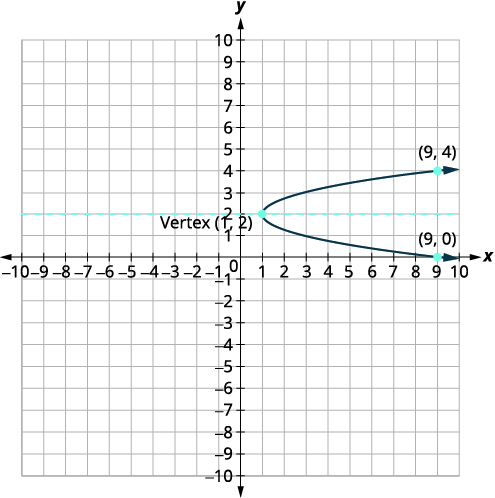 |
Graph x=3(y−1)2+2 using properties.
- Answer
-
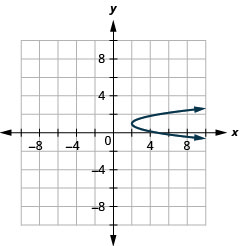
Graph x=2(y−3)2+2 using properties.
- Answer
-
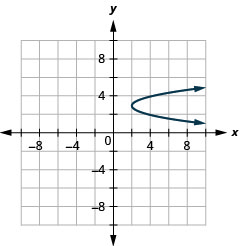
In the next example, we notice the a is negative and so the parabola opens to the left.
Graph x=−4(y+1)2+4 using properties.
Solution:
| x=−4(y+1)2+4x=a(y−k)2+h | |
| Identify the constants a,h,k. | a=−4,h=4,k=−1 |
| Since a=−4, the parabola opens to the left. | |
 |
|
| The axis of symmetry is y=k. | The axis of symmetry is y=−1. |
| The vertex is (h,k). | The vertex is (4,−1). |
| Find the x-intercept by substituting y=0. | x=−4(y+1)2+4 x=−4(0+1)2+4 x=0 |
| The x-intercept is (0,0). | |
| Find the point symmetric to (0,0) across the axis of symmetry. | (0,−2) |
| Find the y-intercepts. | x=−4(y+1)2+4 |
| Let x=0. | |
| y=−1+1y=−1−1 | |
| y=0y=−2 | |
| The y-intercepts are (0,0) and (0,−2). | |
| Graph the parabola. | 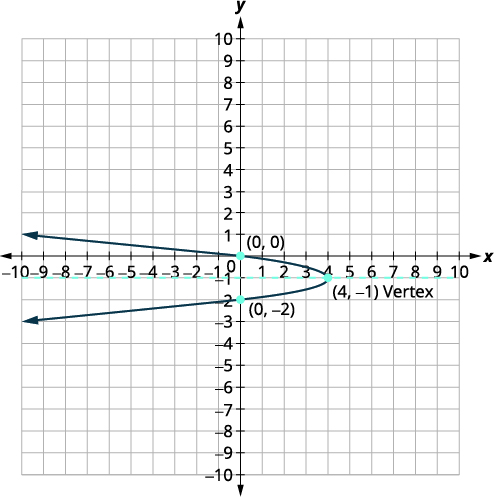 |
Graph x=−4(y+2)2+4 using properties.
- Answer
-
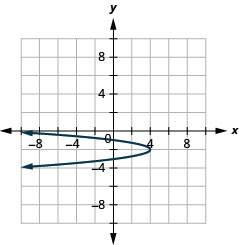
Graph x=−2(y+3)2+2 using properties.
- Answer
-
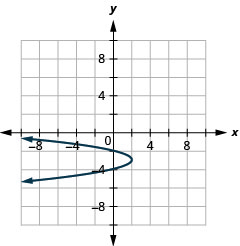
The next example requires that we first put the equation in standard form and then use the properties.
Write x=2y2+12y+17 in standard form and then use the properties of the standard form to graph the equation.
Solution:
|
x=2y2+12y+17 |
||
| Rewrite the equation in x=a(y−k)2+h form by completing the square. |
|
|
| Identify the constants a,h,k. |
x=2(y+3)2−1x=a(y−k)2+h a=2,h=−1,k=−3 |
|
| Since a=2, the parabola opens to the right. | ||
 |
||
| The axis of symmetry is y=k. | The axis of symmetry is y=−3. | |
| The vertex is (h,k). | The vertex is (−1,−3). | |
| Find the x-intercept by substituting y=0. | x=2(y+3)2−1 x=2(0+3)2−1 x=17 |
|
| The x-intercept is (17,0). | ||
| Find the point symmetric to (17,0) across the axis of symmetry. | (17,−6) | |
|
Find the y-intercepts. Let x=0. |
0=2(y+3)2−1 (y+3)2=12 y+3=±1√2=±√22 y=−3+√22y=−3−√22 |
|
| The y-intercepts are (0,−3+√22),(0,−3−√22). | ||
| Approximate so that the points can be located on the graph. | The y intercepts are approximately (0,−2.3) and (0,−3.7) | |
| Graph the parabola. | 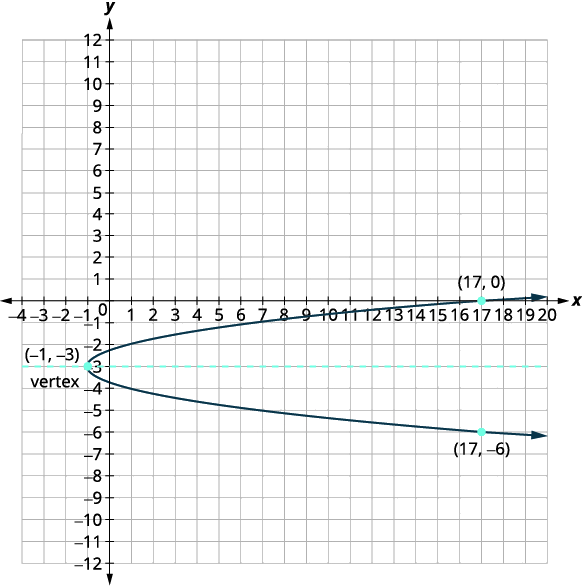 |
- Write x=3y2+6y+7 in standard form and
- Use properties of the standard form to graph the equation.
- Answer
-
- x=3(y+1)2+4
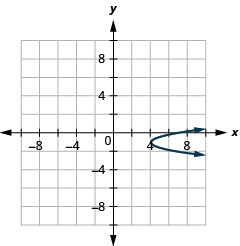
- Write x=−4y2−16y−12 in standard form and
- Use properties of the standard form to graph the equation.
- Answer
-
- x=−4(y+2)2+4
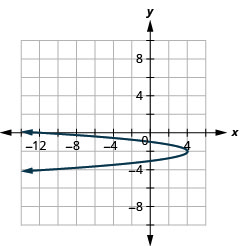
Another Look at Parabolas
We have learned here how to graph both vertical and horizontal parabolas. We started with the basic graphs of y=x2 and x=y2. We then were able to graph y=(x−h)2+k and x=(y−k)2+h. If we subtract the k on both sides of the first equation and h on both sides of the second, we have equivalent equations (they have the same solutions) y−k=(x−h)2 and x−h=(y−k)2. The vertex of the parabolas are the 'simplest' solution that results in 0=0 when being substituted, namely, (h,k). So, the parabolas can be graphed by translating the basic form so that the vertex sits at (h,k). Viewing parabolas in this way will lead more naturally into the next section.
Solve Applications with Parabolas
Many architectural designs incorporate parabolas. It is not uncommon for bridges to be constructed using parabolas as we will see in the next example.
Find the equation of the parabolic arch formed in the foundation of the bridge shown. Write the equation in standard form.

Solution:
We will first set up a coordinate system and draw the parabola. The graph will give us the information we need to write the equation of the graph in the standard form y=a(x−h)2+k.
|
Let the lower left side of the bridge be the origin of the coordinate grid at the point (0,0). Since the base is 20 feet wide the point (20,0) represents the lower right side. The bridge is 10 feet high at the highest point. The highest point is the vertex of the parabola so the y-coordinate of the |
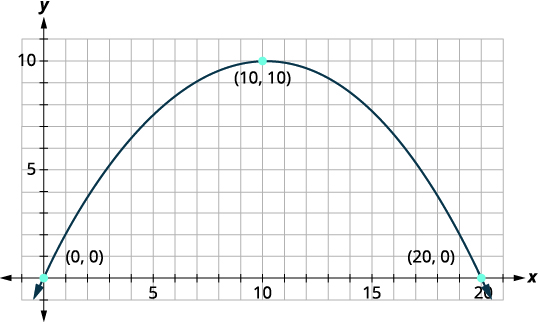 |
| Identify the vertex, (h,k). | (h,k)=(10,10) |
| h=10,k=10 | |
|
Substitute the values into the standard form. The value of a is still unknown. To find the value of a use one of the other points on the parabola. |
y=a(x−h)2+ky=a(x−10)2+10(x,y)=(0,0) |
| Substitute the values of the other point into the equation. | y=a(x−10)2+10 0=a(0−10)2+10 |
| Solve for a. | |
| y=a(x−10)2+10 | |
| Substitute the value for a into the equation. | y=−110(x−10)2+10 |
Find the equation of the parabolic arch formed in the foundation of the bridge shown. Write the equation in standard form.

- Answer
-
y=−120(x−20)2+20
Find the equation of the parabolic arch formed in the foundation of the bridge shown. Write the equation in standard form.

- Answer
-
y=−15x2+2xy=−15(x−5)2+5
Key Concepts
- Parabola: Parabolas are examples of conic sections. The graphs of the equations of the form y=ax2+bx+c and x=ay2+by+c are examples of what are called parabolas.
Vertical Parabolas
|
General form y=ax2+bx+c |
Standard Form y=a(x−h)2+k |
|
|---|---|---|
| Orientation | a>0 up; a<0 down | a>0 up; a<0 down |
| Axis of Symmetry | x=−b2a | x=h |
| Vertex | Substitute x=−b2a and solve for y. |
(h,k) |
| y-intercept | Let x=0 | Let x=0 |
| x-intercepts | Let y=0 | Let y=0 |
- How to graph vertical parabolas y=ax2+bx+c or y=a(x−h)2+k using properties.
- Determine whether the parabola opens upward or downward.
- Find the axis of symmetry.
- Find the vertex.
- Find the y-intercept. Find the point symmetric to the y-intercept across the axis of symmetry.
- Find the x-intercepts.
- Graph the parabola.
Horizontal Parabolas
|
General form x=ay2+by+c |
Standard form x=a(y−k)2+h |
|
|---|---|---|
| Orientation | a>0 right; a<0 left | a>0 right; a<0 left |
| Axis of Symmetry | y=−b2a | y=k |
| Vertex | Substitute y=−b2a and solve for x. |
(h,k) |
| x-intercepts | Let x=0 | Let x=0 |
| y-intercept | Let y=0 | Let y=0 |

- How to graph horizontal parabolas x=ay2+by+c or x=a(y−k)2+h using properties.
- Determine whether the parabola opens to the left or to the right.
- Find the axis of symmetry.
- Find the vertex.
- Find the x-intercept. Find the point symmetric to the x-intercept across the axis of symmetry.
- Find the y-intercepts.
- Graph the parabola.
Glossary
- parabola
- A parabola is one of the conic sections. Though we do not discuss this here, it can be geometrically described: all points in a plane that are the same distance from a fixed point and a fixed line. The graphs of equations of the form y=ax2+bx+c and x=ay2+by+c, a≠0 are examples of parabolas.
Practice Makes Perfect
In the following exercises, graph each equation by using properties.
- y=−x2+4x−3
- y=−x2+8x−15
- y=6x2+2x−1
- y=8x2−10x+3
- Answer
-
1.
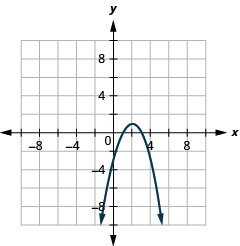
Figure 11.2.83 3.
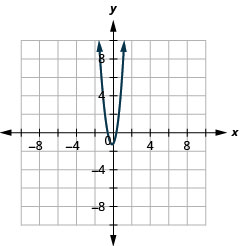
Figure 11.2.84
In the following exercises,
- Write the equation in standard form and
- Use properties of the standard form to graph the equation.
- y=−x2+2x−4
- y=2x2+4x+6
- y=−2x2−4x−5
- y=3x2−12x+7
- Answer
-
5.
- y=−(x−1)2−3
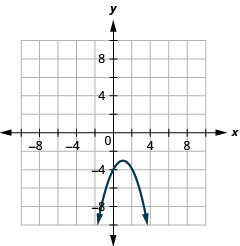
Figure 11.2.85 7.
- y=−2(x+1)2−3
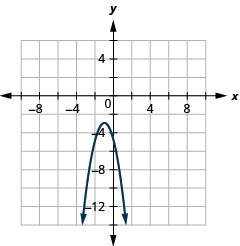
Figure 11.2.86
In the following exercises, graph each equation by using properties.
- x=−2y2
- x=3y2
- x=4y2
- x=−4y2
- x=−y2−2y+3
- x=−y2−4y+5
- x=y2+6y+8
- x=y2−4y−12
- x=(y−2)2+3
- x=(y−1)2+4
- x=−(y−1)2+2
- x=−(y−4)2+3
- x=(y+2)2+1
- x=(y+1)2+2
- x=−(y+3)2+2
- x=−(y+4)2+3
- x=−3(y−2)2+3
- x=−2(y−1)2+2
- x=4(y+1)2−4
- x=2(y+4)2−2
- Answer
-
9.
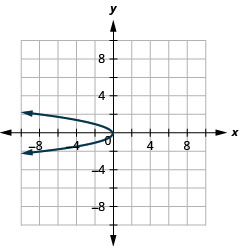
Figure 11.2.87 11.
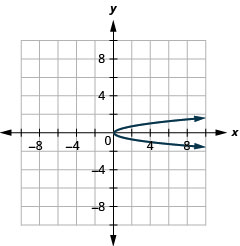
Figure 11.2.88 13.
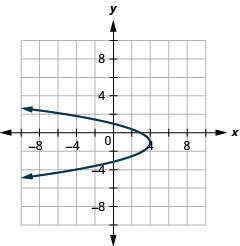
Figure 11.2.89 15.
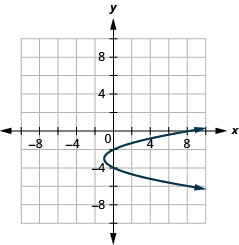
Figure 11.2.90 17.

Figure 11.2.91 19.

Figure 11.2.92 21.
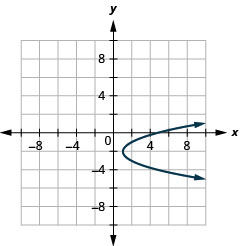
Figure 11.2.93 23.
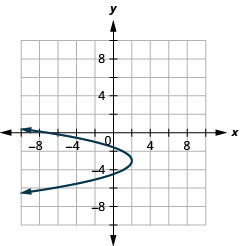
Figure 11.2.94 25.
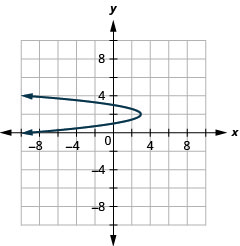
Figure 11.2.95 27.
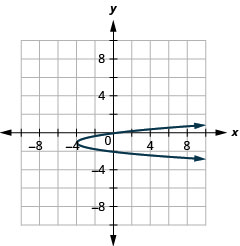
Figure 11.2.96
In the following exercises,
- Write the equation in standard form and
- Use properties of the standard form to graph the equation.
- x=y2+4y−5
- x=y2+2y−3
- x=−2y2−12y−16
- x=−3y2−6y−5
- Answer
-
29.
- x=(y+2)2−9
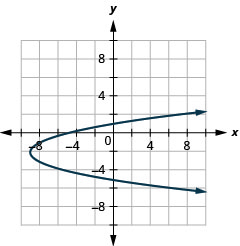
Figure 11.2.97 31.
- x=−2(y+3)2+2

Figure 11.2.98
Write the equation in standard form of the parabolic arch formed in the foundation of the bridge shown. Use the lower left side of the bridge as the origin (0,0).
33.

34.

35.

36.

- Answer
-
33. y=−115(x−15)2+15
35. y=−110(x−30)2+90
- In your own words, define a parabola.
- Is the parabola y=x2 a function? Is the parabola x=y2 a function? Explain why or why not.
- Write the equation of a parabola that opens up or down in standard form and the equation of a parabola that opens left or right in standard form. Provide a sketch of the parabola for each one, label the vertex and axis of symmetry.
- Explain in your own words, how you can tell from its equation whether a parabola opens up, down, left or right.
- Answer
-
37. Answers may vary
39. Answers may vary
Self Check
a. After completing the exercises, use this checklist to evaluate your mastery of the objectives of this section.

b. After reviewing this checklist, what will you do to become confident for all objectives?


